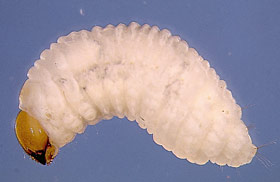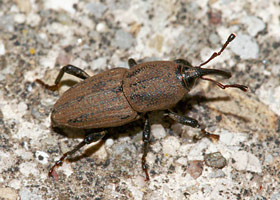Billbug (bluegrass billbug), Sphenophorus parvulus

David Shetlar, The Ohio State University, Bugwood.org.
IPM Steps to Reduce Billbugs
1. Sample for Pest
Confirm the presence of billbugs before you treat.
Where to find it while inspecting: In springtime, billbugs move from leaf litter near turf into the turf and may be seen as adults walking over turf to the spots where they decide to lay eggs. In summer spotty browning of turf will be an indicator. Look for frass (excrement) that looks like whitish sawdust in the turf. They are primarily a pest of bluegrass, so you are less likely to see this species on fescue or ryegrass fields.
2. Proper ID
Are they billbugs?
Size and Appearance: Billbug larvae (grubs) look like other white grubs but do not have legs. Small, creamy white, slightly curved bodies with brown heads; up to 1/2" long when fully developed. Adults are small black weevils (long snouts) about 1/3" long.
3. Learn the Pest Biology

David Shetlar, The Ohio State University, Bugwood.org.
What is the life cycle of billbugs?
Life Cycle: Billbugs overwinter as adults buried in leaf litter and then begin the walk to suitable turf on sunny May or June days. Adult females lay eggs in June, in turf, and the larvae hatch and feed within the turf stem. As they grow the feed closer to the grass plant’s crown, and then go to the roots. Larvae pupate in the soil in late August to hatch in September and October.
Preferred Food Sources: Turfgrass stems, crowns and roots
Preferred Habitat: Adults spend much of their lives in leaf litter near turf and move to turf in spring. Larvae spend their lives in turf; new adults move back to leaf litter in fall.
4. Determine Threshold
How many billbugs are too many?
Threshold: If you see more than two adults per minute on bluegrass or bluegrass mix turf in May or June, you will likely have turf damage. Scouting with the use of a soapy water flush is a very good way to determine population.
5. Choose Tactics
Creating a healthy soil condition and understanding turfgrass’s needs is the first step in reducing turf pests. What can I do to treat, reduce, or prevent billbugs?
Best Management Practices: Switching over your bluegrass mixed turf by overseeding with other varieties will reduce the incidence of this insect. The use of endophytic grasses (specially hybridized grasses containing endophytic fungus) makes grasses less palatable to a variety of turfgrass pests. So far there is no endophytic bluegrass varieties. Growing healthy turf is the best way to reduce billbug damage—do not over irrigate or overfertilize turf.
Treatment Methods: Entomopathogenic nematodes (microscopic soil “worms” that attack insect larvae) can be applied through irrigation and should show reduction in turf damage. Steinernema carpocapsae attacks billbug larvae but care must be taken to ensure the soil is kept moist before, during and after application, so they do not dry out before establishing in the soil. Best time to apply for billbugs is late June or early July when new billbug larvae are hatching. In some cases, insecticides are used but care must be taken to choose the proper mix and apply at the right time.
6. Evaluate
Was the tactic successful? Record the date pests were first noted, and the tactic you used, and its success. Use one of our recordkeeping tools.
For More Information:
Ohio State University Extension Factsheet: Billbugs in Turfgrass
Penn State Extension: Billbugs in Home Lawns
Remember:
When a pesticide application is necessary, all necessary and required precautions are taken to minimize risk to people and the environment and to minimize risk of pesticide resistance or pest resurgence. Pesticide use in your school may be prohibited or regulated by local policies or state and federal regulations. Risk reduction methods can include, but are not limited to, spot-treatment, the use of gel or paste bait formulations placed in inaccessible locations, injection into a crack or crevice, and other methods that reduce potential exposure.